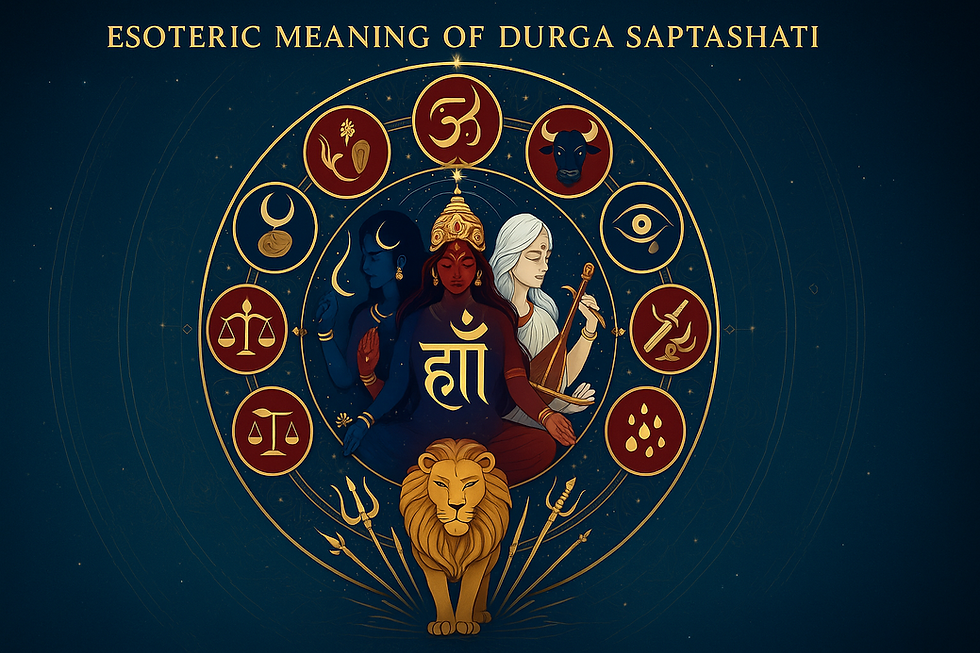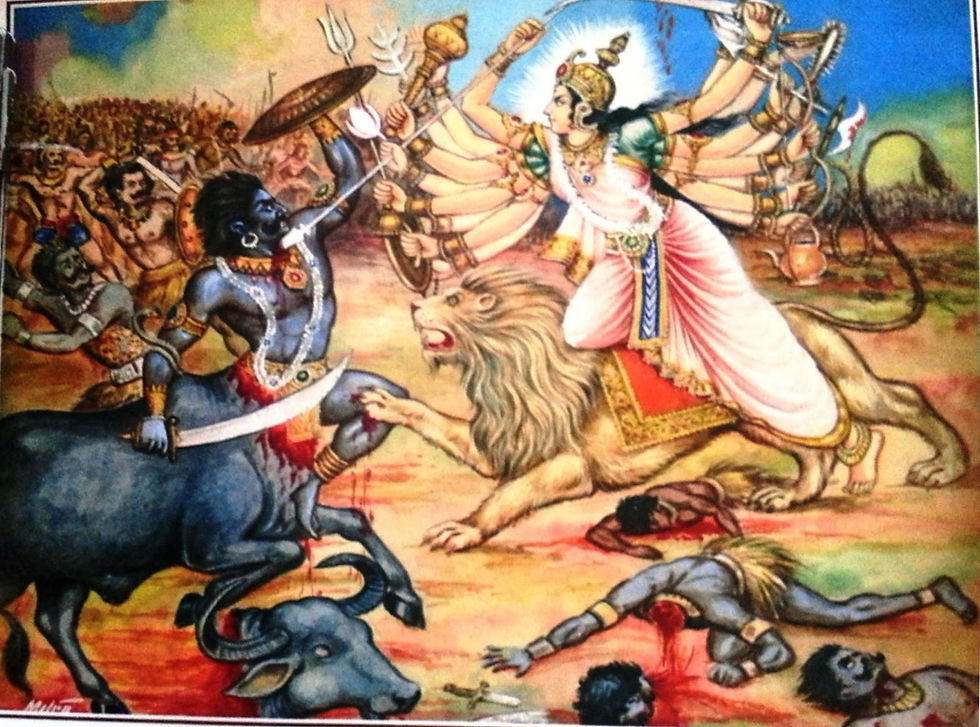Esoteric Meaning of Durga Saptashati — a Manual of Inner Freedom
- Dr Ananth Nalabanda
- Oct 5
- 4 min read

Sairam, dear ones. I hope your Navaratri was blessed. By the Mother’s grace, I felt moved to share a distilled, inner reading of the Durga Saptashati (also called Devi Mahatmyam), drawing on insights I have gathered since my teens and with gratitude to Brahmasri Samavedam Shanmukha Sarma garu, Om Swami ji, and Swami Sivananda. May their guidance be honoured here.
The Soul’s One Longing
Beneath the bustling layers of sensory, social, and intellectual desires is one current: the soul’s longing for freedom. Every yearning—however it appears—can be gathered into this single inward urge to be unbound, to rest in one’s own Self. Durga Saptashati is a poetic epic of that journey to freedom: dramatic, musical, and transformative—uplifting emotion, clarifying intellect, and steadying the seeker’s resolve.
Three Great Movements of Shakti
The text, set within the Mārkaṇḍeya Purāṇa, unfolds in three Charitras (cycles), mirroring the seeker’s ascent:
Mahākāli – breaks tamasic inertia, fear, and darkness.
Mahālakṣmī – organizes and channels energy; mastery over restless rajas.
Mahāsarasvatī – illumines with sattvic clarity; pierces even subtle veils.
As in the Gītā’s three-part structure, each Charitra marks a deep reconstitution of our inner being.

The Demons as Inner Obstacles
The battles are not about outer enemies. They map our inner alchemy.
Madhu & Kaitabha — sweet/bitter; praise/blame.The first hurdle is rising above duality in taste and tone. Perception remains; reactivity drops. Vishnu-like viveka sustains this equipoise.
Mahīṣāsura — rage & lust as raw energy.These cannot simply be “killed”; they must be transmuted and harnessed—like taming a powerful horse. This is Devi as Śakti.
Dhumralocana — smoky vision, distraction.Purify sight/attention; see through the haze of information and illusion. Establish Right View.
Caṇḍa & Muṇḍa — passion, violence; head-talk and inner conflicts.Even noble passions can hijack sādhana. Let guilt and regret pass like clouds; return to centre.
Raktabīja — desire that multiplies.Like blood spawning clones, fulfilled desires beget more. Kali’s “drinking” signifies root-level containment—seeing desire’s mechanism and withdrawing fuel.
Śumbha & Niśumbha — borrowed good/bad; complacent sattva.Beyond tamas and rajas, even sattva is a glass pane—clear yet obstructing. Breaking conditioning, one rests in intrinsic compassion free of fear, guilt, and pride.
Sūraṭha & Samādhi — the boon.Sūraṭha (“excellent vehicle”) is insight itself; Samādhi is oneness. This is the seal on the Devi’s grace—the soul abiding in freedom.
The Three Knots and the Seven Steps
Along the ascent the seeker encounters the three granthis (knots):
Brahma-granthi — creates thought/desire (mala).
Viṣṇu-granthi — sustains and multiplies it (vikṣepa).
Rudra-granthi — impels action, fulfilment, or destruction.
Six “asura” stations mirror the six main chakras; the seventh is integration in Suratha–Samādhi. Freedom is moving through and beyond all three knots.
Action, Worship, Knowledge — The Remedy Trio
Ancient masters offer a precise therapy:
Karma Yoga (selfless action) scrubs mala (the “dirt” of kamā-krodha-lobha).
Upāsana (devotional worship) stills vikṣepa (mind’s tossing).
Jñāna (direct insight) pierces āvaraṇa/ajñāna (the subtlest veil), even when sattva itself becomes a quiet obstacle.
This is why the Devi is worshipped in sequence as Mahākāli → Mahālakṣmī → Mahāsarasvatī: from destruction of obstruction, to prosperity of energy rightly ordered, to illumination—and finally Self-realisation.
The Battlefield Is the Mind-Field
Lion (vahana) — courage, dharma, inner steadfastness.
Divine weapons — the gods’ powers loaned to Devi = our own higher faculties.
Victory hymns (stuti) — samskāras of light that stabilise new awareness after each purification.
The text reminds us: no seeker is an island. Inner work has cosmic relationship; when intention aligns with universality, universal forces assist.
Mantra and the Mother’s Code
Durga Saptashati is also Mantra-Śāstra. Each verse is charged. As a hint, the opening points to the Hṛīṃ bīja—Surya–tanaya (Agni) → Ra/“Ram”, varṇī (a hook) + eighth Manu letter Ha → Hṛīṃ—the Māyā-bīja of the Divine Mother.
A daily, reverent pārāyaṇa is traditionally prescribed to avert calamities and to burn mala, vikṣepa, and āvaraṇa, preparing the seeker for grace.
Navārṇa Mantra: oṁ aiṁ hrīṁ klīṁ cāmuṇḍāyai vicce
Aiṁ (Sarasvatī) — luminous intelligence
Hrīṁ (Lakṣmī) — radiant power, heart’s expansion
Klīṁ (Kālī) — magnetic transformationChanted with understanding, it balances wisdom, energy, and protection.
Practice Blueprint (from Epic to Everyday)
Equanimity training: politely receive both praise and blame; choose responses consciously.
Transmute energy: convert anger/lust into focused tapas (study, service, disciplined breath and movement).
Guard the gates: reduce visual and informational clutter; curate what you see and hear.
Let clouds pass: when inner conflict surges, witness without clinging; return to mantra.
Starve desire loops: watch the spark before it becomes flame; soften the body, lengthen exhale, name the impulse, release.
Go beyond borrowed morality: live dharma from inner clarity, not compulsion or fear.
Make time for solitude: two journeys—Self-realisation and death—are ultimately walked alone; honour silence.
One-Glance Inner Map
Madhu–Kaitabha → Duality of sweet/bitter → Non-reactivity
Mahīṣāsura → Rage/lust energy → Channel & transmute
Dhumralocana → Smoky perception → Purify attention
Caṇḍa–Muṇḍa → Passion & conflicts → Detachment / tapas
Raktabīja → Desires proliferate → Root-level containment
Śumbha–Niśumbha → Borrowed good/bad → Break conditioning
Suratha–Samādhi → Insight & Oneness → Abide as Freedom
The Heart of the Teaching
Durga Saptashati is not about mechanical chanting. It is a living yajña—a transformation of perception and response, verse by verse, layer by layer, until ego dissolves and the seeker rests in the Mother.
May Mahākāli clear our obstructions, may Mahālakṣmī order our energies, and may Mahāsarasvatī flood us with light—until only Oneness remains.
Jai Mā.















Comments